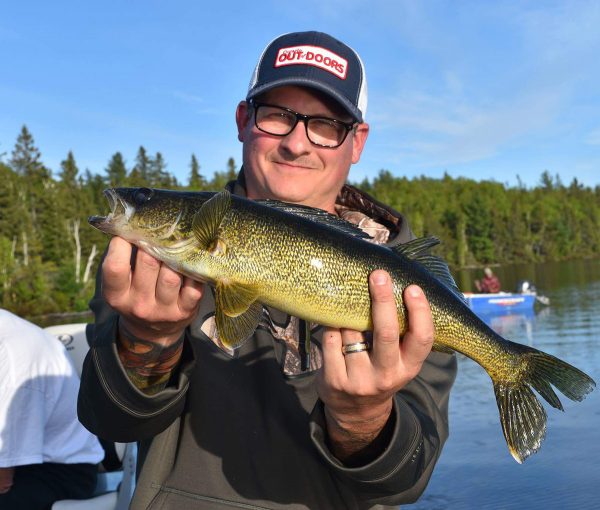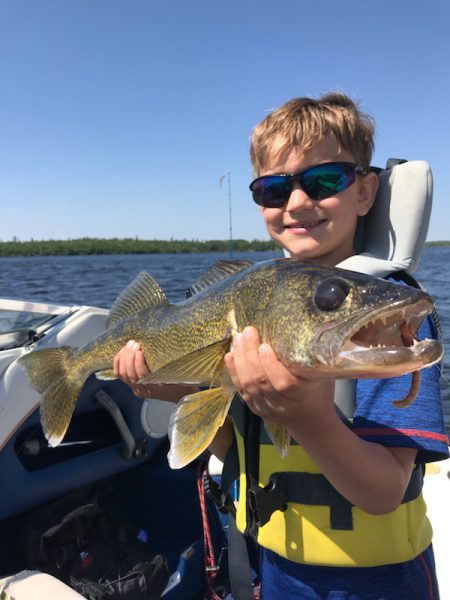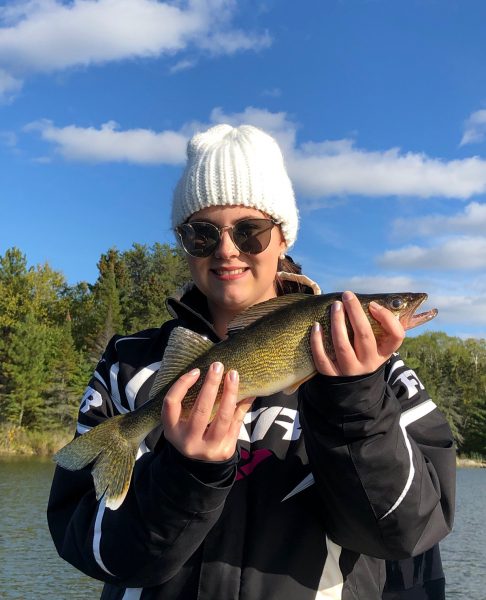Walleye
 Walleye are the essence of a northern experience. Where these golden fish thrive, the waters are rich and clean. They have a reputation for being a somewhat picky fish, yet they’ll snap a jig so hard you can lose your rod. Walleye are also stubborn when it comes time to reel them in.
Walleye are the essence of a northern experience. Where these golden fish thrive, the waters are rich and clean. They have a reputation for being a somewhat picky fish, yet they’ll snap a jig so hard you can lose your rod. Walleye are also stubborn when it comes time to reel them in.
Anyone who thinks walleye don’t fight has never caught a big one. Trophy walleye are broken off every year by anglers who underestimate the power of these fine fish. Although the average walleye weighs 1 1/2 to 3 pounds (.68 to 1.36 kg), the Ontario record is a hefty 22.25 pounds (10.1 kg). Ten-pounders are possible anywhere.
Walleye are often willing biters that have turned kids of all ages onto the joys of angling. They are light-sensitive fish, and wave action from wind and the low-light conditions of morning and evening can trigger intense feeding activity.
Jigs weighing 1/8- to 3/8-ounce, dressed with soft-plastic twister-tails (yellow, white, black or chartreuse are standards) or shad bodies (perch or firetiger), bucktail, or live bait such as leeches, worms, or minnows, are top producers. Minnow plugs like Rapalas and Rebels and crankbaits such as Shad Raps, Wildeye Minnows, or Wally Divers cast or trolled around shoals and weedbeds account for large numbers of fish as well.
 Medium-weight spinning tackle rigged with 8- to 14-pound-test line will handle most situations and baits.
Medium-weight spinning tackle rigged with 8- to 14-pound-test line will handle most situations and baits.
A good depth sounder is a must on most lakes for finding structure that attracts these normally bottom-holding fish. In some lakes, however, big walleye suspend and feed on fattening baitfish like cisco and smelt. Again, a fish finder can help you pinpoint these fish. Hydrographic charts, showing depths and bottom features, are available for many of our drive-to lakes. Experienced anglers never leave the dock without a depth sounder, a chart, or both.
 For first-timers, a good guide is always a smart bet. Besides knowing local hotspots, most guides are willing to give on-the-water fishing seminars on tackle rigging and techniques for walleye.
For first-timers, a good guide is always a smart bet. Besides knowing local hotspots, most guides are willing to give on-the-water fishing seminars on tackle rigging and techniques for walleye.
Walleye are found in every region of the province. In most areas, fishing begins in mid-May, peaks in June, and remains steady throughout most of summer. Fall fishing, while not as consistent, often produces the biggest fish of the year. Many lakes also offer hard-water walleye fishing, often from the comfort of a heated ice hut.
Of course, where the walleye really shines is in the pan. A traditional shore lunch of fried walleye fillets, served with sizzling potatoes and piping-hot beans, and enjoyed by a glistening blue lake, is renowned as one of the world’s finest feasts. Once you’ve tasted truly fresh walleye from a northern lake, you’ll never look at restaurant fish in the same way.



